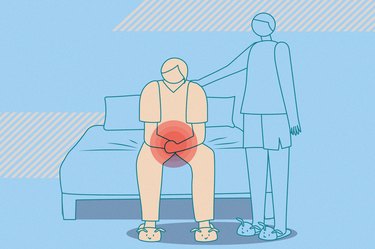
For many people, tampons are the go-to option for comfort, reliability and leak protection during menstruation. In general, tampons are very safe to use because they are considered medical devices — meaning quality and use guidelines are regulated by the Food and Drug Administration (FDA).
But tampons can also be intimidating to use and come with a lot of questions — can you sleep with a tampon in? And more importantly, is it safe to sleep with a tampon in?
Video of the Day
Video of the Day
The answer is yes. "I absolutely support sleeping with a tampon, especially when a person moves in bed and can easily soil a pad or their bed," says Wendy Goodall McDonald, MD, a board-certified ob-gyn at Women's Health Consulting.
Still, there are some things to know about proper overnight tampon use, Dr. Goodall McDonald says.
We spoke to two experts about sleeping with a tampon in to better understand the risks and benefits along with how to use tampons safely at night. Here's what you need to know.
The Risks of Sleeping With a Tampon In
The main concern with overnight tampon use is the length of time between changing out your tampon. Per FDA regulations — and any listed instruction on a tampon box — you should be changing your tampon every four to eight hours to avoid the risk of infection or irritation.
Unlike your waking hours when you can track the time between tampons and make a quick trip to the bathroom, it's harder to keep track when you're sleeping. But if tampons aren't changed out every four to eight hours, you do run the risk of developing bacterial vaginosis (BV) or even Toxic Shock Syndrome (TSS).
BV is a type of inflammation in the vagina caused by an overgrowth of bacteria, according to the Mayo Clinic. Symptoms include vaginal itching, a "fishy" vaginal odor, burning when peeing and thin white, gray or green vaginal discharge. It can also cause pain when inserting a tampon.
TSS occurs when there's an overgrowth of bad bacteria from an item — like a tampon, or a surgical tool — which causes flu-like symptoms, fever and sometimes seizures, Dr. Goodall McDonald says. In some cases, TSS is life-threatening, but the condition is extremely rare: "[TSS] only occurs in 1 out of every 100,000 people who use tampons," Dr. Goodall McDonald says.
"The biggest misconception about toxic shock syndrome is that it's caused by tampons. In reality, TSS is linked to tampons but not necessarily caused by them," says Melanie Bone, MD, a board-certified ob-gyn and member of Daye's medical board. "Anything that is left in the vaginal canal for too long can put you at risk of TSS, whether it's a tampon or menstrual cup — that's why they both come with a wearing time limit."
All in all, the risks involved with overnight tampon use come down to being careful about how long you wear one, although most complications are very rare. Simply put? If you accidentally sleep with your tampon in for more than eight hours, take it out and use a fresh pad or tampon as soon as possible.
How to Safely Wear a Tampon to Bed
The most important considerations for overnight tampon use is duration (how long you're wearing it) and the type of tampon you're wearing. Here's what to keep in mind:
- Set your alarm. "It is safe to wear a tampon whilst sleeping, you just need to be mindful of how long you're sleeping for," says Dr. Bone. She recommends setting your alarm for the morning to make sure you don't sleep past the eight-hour mark.
- Change your tampon as soon as you wake up, even if it's been less than eight hours.
- Wear the right tampon. "Use a size that can support your flow for that long, but no larger because that can increase risk of bacterial overgrowth because of increased surface area of the tampon," says Dr. Goodall McDonald. Always use a tampon that fits your absorbency needs, and resist the urge to use a larger or super-absorbency tampon if you don't need it.
Alternatives to Sleeping With a Tampon In
If you love tampons — and you're mindful about the two points above — you're definitely good to use them at night. But for those who can get a little lax about safety, or even just don't find them comfortable, there are other overnight options to consider.
Menstrual Cup
Menstrual cups are a great option for those who want to sleep in. Made of body-safe silicone or latex rubber, menstrual cups are small, flexible cups that are inserted in the vagina to "catch" blood. They're reusable and eco-friendly, and the best part is you can wear them for up to 12 hours — meaning they're perfect for overnight protection.
Dr. Goodall McDonald recommends the Honey Pot menstrual cups ($23.99, TheHoneyPot.co), but notes it's important to sanitize cups between periods to prevent bacteria growth.
Menstrual Disc
Menstrual discs work exactly like cups — the only difference is that discs are often for one-time usage only and they're shaped like a disc rather than a cup. Which one you use comes down to personal preference. Some people find the disc shape more comfortable than the cup, and vice versa.
Like cups, menstrual discs can be worn for up to 12 hours. For those looking to make the switch, Nixit's reusable menstrual disc ($42, Nixit.com) is easy to use and super comfortable to wear.
Menstrual Underwear and Pads
Finally, there are non-insertive options for overnight period care. Menstrual underwear and washable, reusable pads are perfect for those who want to free bleed and not worry about changing out a disc, cup or tampon. The only downside is the risk of leakage, which can happen with underwear and pads.
TomboyX (From $11.99, TomboyX.com) has a line of menstrual underwear that's size-inclusive and gender-neutral for those looking for a comfortable fit.
So, How Bad Is It Really to Sleep With a Tampon In?
Sleeping with a tampon is safe — but you should remain vigilant about changing out your tampon at (or ideally before) the eight-hour mark and be aware of the risk for TSS.
For those who aren't so great about changing out their overnight tampons, consider wearing safer long-wear options like period underwear, a menstrual disc or a menstrual cup.
Was this article helpful?
150 Characters Max
0/150
Thank you for sharing!
Thank you for your feedback!
Is this an emergency? If you are experiencing serious medical symptoms, please see the National Library of Medicine’s list of signs you need emergency medical attention or call 911.



